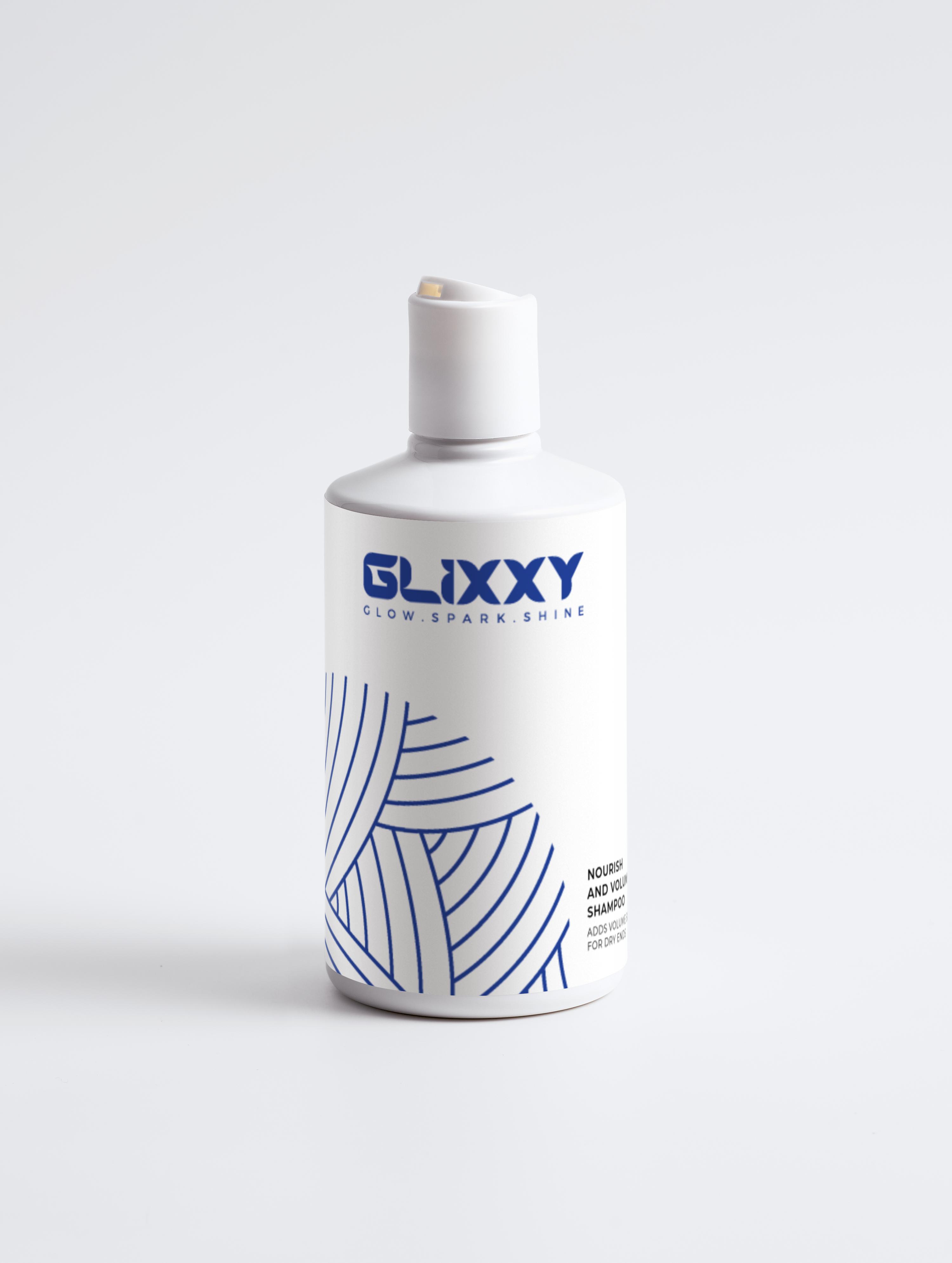Hydra-Glow Collection Box
Hydra-Glow Collection Box
15 Items Left
Our Sale Ends In
Sale is end!

Couldn't load pickup availability
Description
Description
Glixxy is offering the amazing Hydra-Glow Collection Box, which includes Sunscreen SPF30 for Face and body, Double Boost Hydration Gel, and Brightening Eye Cream. These products will protect your skin and body from the harm caused by the sun, nourish it by moisturizing it deeply, and brighten under-eye areas.
Products Included
Sunscreen SPF30 for Face and Body
Volume 150 ml / 5.07 fl oz
Key Ingredients:
- Aloe Juice - Lightly hydrates while promoting refreshed skin
- Berry Extract - Delivers antioxidant support to help defend against environmental aggressors
- Fruit Extract - Revives dull skin
Double Boost Hydration Gel
Volume 30 ml / 1.01 fl oz
Our Double Boost Hydration Gel contains Sodium PCA, Hyaluronic Acid, Aloe Leaf Juice, and Sage Extract, among many other ingredients. The full ingredient list is available here.
Brightening Eye Cream
Volume 15 ml / 0.51 fl oz
This product has hydrating ingredients like Shea butter, Ginkgo extract, and Horse chestnut extract. You can learn more here.
Star Features
- UV defence
- Hydrating and nourishing
- Gluten free
- Nut free vegan
- Long-lasting protection
- Rapid absorption into the skin
- Fewer fine lines
- Amazing body care
Concerns Addressed
- Dehydrated and damaged skin
- Under-eye fatigue
- Dullness and rough texture
- Irritated and sensitive skin
- Sun damage
Certifications
COSMOS NATURAL Certificate
Ingredients
Ingredients
How to use
How to use
Share this product
Frequently Asked Questions
How long will it take to receive my order?
How long will it take to receive my order?
Orders are typically processed within 1–2 business days. Shipping time depends on your location and chosen delivery method. You’ll receive a tracking link via email once your order is on the way.
Are the products suitable for sensitive skin?
Are the products suitable for sensitive skin?
Yes, our products are formulated with gentle ingredients. They are dermatologically tested and safe for sensitive skin. However, we recommend doing a patch test before full use.
Can I pay later with Klarna?
Can I pay later with Klarna?
Yes, we offer Klarna as a payment option at checkout. With Klarna, you can choose to pay later or split your payment into installments. Simply select Klarna at checkout and follow the prompts to complete your order.
Is Glixxy 100% vegan and cruelty-free?
Is Glixxy 100% vegan and cruelty-free?
Yes, Glixxy is committed to being 100% vegan and cruelty-free. All our products are crafted without animal-derived ingredients and are never tested on animals. We prioritize ethical beauty, ensuring our offerings align with compassionate and sustainable practices.
How do I return a product?
How do I return a product?
To return a product, contact our support team within 14 days of delivery. Make sure the item is unused and in its original packaging. Once approved, we’ll send return instructions to complete the process.
From The Glixxy Desk
What are the 12 common hair care problems
This blog will address following Common Hair Care Problems & Quick Fixes Dry, frizzy, thinning, split ends, dandruff, and more Hydrate, nourish, and protect with Glixxy shampoos & conditioners Watch scalp health, stress, and heat exposure Consult dermatologists or trichologists for severe issues Bad hair days aren’t just about style; they usually come from real hair problems hiding underneath. From dandruff and dryness to frizz, breakage, and fading color, these issues affect almost everyone at some point. The good news? Most of them can be managed once you know the cause and use the right care routine. At Glixxy, we’ve seen how the right shampoo, conditioner, or scalp treatment can completely change the way hair feels and looks. In this guide, we’ll walk through the most common hair care problems, why they happen, and simple fixes you can start today. Want stronger, healthier hair? Start with Glixxy hair care solutions to bring instant hydration and shine. Discover Easy Daily Hair Fixes 1. Dryness and Dehydration Dry, brittle strands are one of the most common hair problems. Instead of being soft, the hair feels rough, dull, and prone to snapping. This often happens when your scalp doesn’t produce enough natural oils, or when heat styling, harsh shampoos, and even sun exposure strip away moisture. Causes of Dry Hair: Over-washing or using sulfate-heavy shampoos Frequent heat styling (straighteners, blow-dryers) Environmental stress (sun, wind, hard water) Lack of hydration in your overall diet Glixxy Moisturising Shampoo, followed by the Moisturising Conditioner, restores hydration from root to tip. 2. Frizz and Flyaways Frizz is one of the most common and most frustrating hair struggles. It usually happens when the hair cuticle (the outer layer) lifts, letting moisture from the air sneak in and cause strands to swell. The result? Puffy, hard-to-manage hair with little flyaways sticking out everywhere. Humidity, over-washing, harsh shampoos, and even heat styling make it worse. The good news? Frizz isn’t permanent. With the right care, you can smooth your strands and bring back shine. Look for products that restore moisture balance, seal the cuticle, and give hair lightweight hydration without weighing it down. Pro Tip: Always rinse your hair with cool water at the end of your shower. It helps close the cuticle and lock in smoothness. For a fresh, frizz-free feel, pair Glixxy’s Moisturising Shampoo with the Fresh Conditioner (Citrus Cocktail). Together, they keep strands hydrated, smooth, and light without the heavy buildup. 3. Hair Fall and Thinning Losing 50–100 strands a day is normal, but when clumps start showing up in the shower drain or your ponytail feels thinner, it’s a sign of excessive shedding. Hair fall isn’t just about appearance; it can chip away at confidence and self-esteem. The triggers? Stress, hormonal shifts, nutrient gaps, harsh styling, and even scalp conditions. A weak scalp foundation means weaker roots, making strands more likely to break or fall out. You Know What? Crash diets and skipping protein-rich meals can speed up hair thinning just as much as genetics. 4. Split Ends and Breakage Split ends happen when the hair’s outer layer wears down, often from heat styling, rough brushing, or chemical treatments. Unlike hair fall, which starts at the root, breakage begins mid-shaft, making strands look frayed, dry, and uneven. Breakage and shedding aren’t the same: shedding is a natural loss from the scalp, while breakage is a sign of weakened hair structure. Left untreated, split ends creep upward, thinning out the length and making growth feel impossible. Pro Tip: Skip the “miracle” serums promising overnight fixes. Instead, trim your ends regularly, use protective hairstyles, and switch to strengthening care. Glixxy’s Gloss Conditioner can smooth cuticles, reduce snapping, and keep hair stronger between trims. 5. Dandruff, Itchiness, and Buildup A healthy scalp is the foundation of healthy hair. But when flakes, itchiness, or residue appear, it’s easy to confuse one issue for another: Dandruff → usually linked to an overgrowth of yeast, not just dryness. Dry scalp → lack of moisture, often worsened by harsh shampoos. Product buildup → residue from styling products clogging pores and weighing strands down. Each has its own cause, and fixing it means treating the scalp, not just the hair. Ignoring scalp health can trigger more shedding, irritation, and dullness over time. Things to Know: Dandruff isn’t always caused by dryness; often it’s a yeast imbalance (Malassezia) on the scalp. Switch to scalp-friendly, Deep Cleanse Scalp Scrub and gentle exfoliating treatments. 6. Oily Roots and Greasy Hair Few things are more frustrating than washing your hair in the morning, only to find it looking flat and greasy by evening. Oily roots happen when the scalp’s sebaceous glands produce too much sebum. Ironically, overwashing can make things worse: stripping natural oils signals the scalp to produce even more. The result? Hair that looks heavy, limp, and dull, no matter how often you wash it. Pro Tip: Train your scalp by spacing out washes gradually. Use a lightweight, pH-balanced Glixxy’s Shine Shampoo to pair well with this routine to keep roots fresh without over-drying ends. 7. Heat, Color, and Chemical Treatments Flat irons, curling wands, bleaching, and smoothing treatments can transform your look, but at a cost. High heat breaks down the hair’s natural keratin bonds, while coloring and chemical processes strip away moisture and protective layers. Over time, strands become weaker, drier, and more prone to breakage. The hard truth: No product can fully “reverse” permanent damage. Most “damage repair” serums only patch up the surface, giving temporary smoothness. That’s why prevention matters more than cure. 8. Texture Troubles Every hair type has its own battles. The secret isn’t fighting your natural texture, but understanding it. Your hair’s porosity (how well it absorbs and holds moisture) determines what actually works. Curly hair often faces shrinkage, tangles, and dryness. Straight hair struggles with flatness, limp volume, and oily roots. Wavy hair with frizz and uneven texture is the biggest headache. Pro Tip: Test your hair porosity with the simple “strand-in-water” trick; low porosity floats, high porosity sinks. This helps you pick the right products and routine for your unique texture. 9. Growth Frustrations Waiting for hair to grow can feel like watching paint dry. Many people chase quick fixes, miracle oils, supplements, or trimming myths, but the truth is: genetics set your maximum growth rate. On average, hair grows about half an inch per month. That said, lifestyle choices can speed up or slow down your progress. Stress, poor diet, tight hairstyles, or scalp issues can all stall length retention. Pro Tip: Prioritize scalp health, balanced nutrition, and gentle routines over pricey “hair growth pills.” A healthy foundation encourages your hair to reach its natural potential. 10. Lifestyle & Environmental Stress Your daily routine might secretly be working against your hair. Pollution can coat strands with dust and toxins, leaving them dull and weak. Hard water (rich in minerals) often causes buildup that blocks moisture absorption. Even lifestyle habits like tight ponytails, poor sleep, or constant hat-wearing can contribute to thinning, breakage, and scalp irritation. Here’s a catch: Small changes make a big difference. Switching to satin pillowcases, wearing protective updos, and rinsing hair with filtered water can reduce hidden daily damage. 11. Premature Greying Noticing white or silver strands in your 20s or 30s? That’s premature greying. The main trigger is genetics, but stress, vitamin B12 or copper deficiency, and smoking can speed it up. Once hair loses melanin (the pigment that gives it color), it can’t naturally return. But good nutrition, antioxidants, and gentle scalp care may slow the process. Pro Tip: Skip harsh dyes. Instead, protect natural pigment with Glixxy Colour Care Shampoo, designed to save your hair color and hair's health. 12. Head Lice Infestation Head lice are tiny parasites that feed on your scalp and cause intense itching. They spread quickly through combs, hats, or close contact, especially in children, but adults aren’t immune either. Unlike dandruff, lice come with nits (eggs) stuck to hair shafts. Medicated shampoos, natural oils like neem, and a fine-toothed lice comb are the most effective treatments. Pro Tip: Don’t share hair accessories and wash bedding often to stop lice from coming back. When to See a Professional: Signs It’s More Than Just “Bad Hair” Sometimes hair troubles aren’t just cosmetic; they’re a sign of deeper issues. Sudden bald patches, severe itching, burning, or rapid shedding should not be ignored. At this stage, a visit to a dermatologist or trichologist is worth it. These experts can rule out conditions like alopecia, infections, or hormonal imbalances and guide you toward real solutions instead of endless trial-and-error. Pollution and stress ruining your hair every day? Waiting too long can make hair damage harder to reverse. Act now, prevention works better than repair. Get Back Fuller, Healthier Hair Healthier Hair Starts with Small Changes Hair struggles are more common than you think, and most are manageable with simple, consistent habits. The key is to start small: adjust your wash routine, protect your strands from heat, or give your scalp some extra care with Glixxy natural COSMO certified hair products. These little changes add up faster than you imagine. Fix One Habit This Week and See the Difference FAQs: 1. What causes the most common hair problems? Hair issues often stem from a mix of factors; stress, genetics, heat styling, chemical treatments, and scalp health. Using harsh products or skipping care routines can also worsen problems. 2. How can I fix dry and frizzy hair naturally? Focus on hydration and protection. Try using moisturizing shampoos and conditioners like Glixxy Moisturising Shampoo and Fresh Conditioner, Citrus Cocktail. Limit heat styling and sleep on satin pillowcases to reduce frizz. 3. Can diet affect hair health? Absolutely. Protein, vitamins, and minerals are essential for strong, shiny hair. A balanced diet plus hydration can improve growth and reduce breakage over time. 4. How often should I wash my hair? Wash based on your hair type: oily roots need more frequent cleansing, while dry or curly hair benefits from less frequent washes. Using scalp-friendly, pH-balanced products like Sensitive Scalp Shampoo can help maintain balance. 5. What’s the difference between dandruff and dry scalp? Dry scalp flakes are usually small, white, and tight, caused by a lack of moisture. Dandruff flakes can be oily or larger, often caused by yeast imbalance or scalp buildup. Choosing products like Deep Cleanse Scalp Scrub, Rosemary & Mint helps address buildup effectively.
Learn moreIdentify Your Hair Type and Unlock the Best Styling Tips
What is my hair type? Curious to know about your hair type or how to style it. Your hair type is all about the curl pattern of your hair. The four different types of hair are identified based on curl patterns found on different parts of the head. You can style them depending on your hair type and personal preferences. Here, the most important thing to remember is that your hair is beautiful regardless of what people say about it. Hair helps boost your personality and deserves respect, too. Whether thick, fine, short, long, glossy, matte, coily, curly, or straight, what it needs is good care. Your self-care routine is incomplete unless you include your hair in it. So, first understand well about your hair types well and then move ahead. Let's figure out all hair types, how to care for each, factors affecting hair like density, porosity, and diameter, and how to style them. What does it mean by hair type? Hair type is basically determined by the hair's curl pattern, and the amount of curl by the hair follicle. The straight, curly, wavy, or coily hair types are based on the shape of your hair follicle. The more asymmetrical or oval the hair follicle is, the curlier the hair will be. Genetics also affects your hair type. You can temporarily change your hair curl pattern with chemicals or heat, but your innate curl pattern is defined in your DNA. Whenever your hair goes through its natural growth cycle, the genetic characteristics restore its intrinsic type. Your hair type is unique and genetically transferred. Embrace your natural hair texture and shape because it's something that you can't change. What are the four main types of hair? All hair types are yet divided into four categories based on their curl patterns, including straight hair, wavy hair, curly hair, and coily hair. Hair Type Features What does it look like? Straight No curl, Hair lies flat Shiny, smooth hair strands Wavy Tend to frizz, loose waves “S”-shaped waves Curly Defined curls, springy Ringlet or spiral curls Coily Tight curls or zig-zag pattern Very tight kinks or coils These main hair types are subdivided based on the looseness or tightness of the curls and coils, with subcategories of A, B, or C for each. It may sound simple, but a complicated human feature actually is. It's not necessarily defined that you have just one hair type; a combination is also noticed in numerous people. You could have hair type 4A at your temples and 4C at your crown. Let's understand each hair type, its style needs, and how to keep it healthy. How to style and care for your hair type Styling depends on the hair type and preferences. Keep your hair healthy and strong by taking good care of it and following a proper care routine. The following is the breakdown of all hair types: Straight Hair Straight hair (type 1 hair) lies flat and has no natural curl. The individual hair strands may be thick or thin, fine or coarse, but have no wave from root to tip. Care and style tips: Straight hair becomes oily. Most stylists suggest checking the label of the product you're buying to see if it contains oil or not. Make sure that it does not add extra oil to your hair. Try to avoid heavy serums or butters; instead, use a texture spray and dry shampoo. If you wash your hair too often, it can cause your scalp to overproduce oil. Use dry shampoo if you have oily, straight hair to control oil production. Choose a hairstyle based on your face shape or ask a stylist to pick one. A popular style, chin-length blunt cut, is pretty well for straight hair. Wavy hair Wavy hair or type 2 hair has "S" shaped waves. These loose waves usually tend to frizz. Let's delve deep into the types of wavy hair: Type 2A The natural state of wavy hair is a tousled, gentle texture. From the hair follicles (roots) to eye level, hair is fairly straight. And from eye level to the hair ends, there is an undefined, loose wave. Don't use creamy or oil-based products as they may flatten out the wave. Instead, use a gel to define your hair waves or improve the base with a light mousse. Type 2B In case of type 2A and type 2B, hair curls from the mid-section to the hair ends. In this type, curls are of a more defined S shape. You need to put a little extra effort into straightening them. But a spritz of salt spray is enough to create a beachy look. It is the best hair type for the balayage trend, where stylists hand-paint color on the outer layer. You won't have to go out of your way to style the balayage trend on your wavy hair. Type 2C This type of wavy hair has the most well-defined S-shaped waves. This hair is often thick and may tend to frizz in damp or cold weather. If you are dealing with frizz and have no solution. Try a diffuser on the end of your blow dryer to remove frizz. Always choose anti-humidity products, especially wherever you have to face environmental factors like salt water or hard water. Several lightweight mousses are infused with anti-humidity ingredients along with moisture. Avoid excessive heat while styling to keep your hair frizz-free and healthy. Always use a heat protectant first to prevent heat damage to your hair. Curly hair Type 3 hair (curly hair) has ringlet or spiral curls. The following types of curly hair are defined based on looseness and tightness of curls: Type 3A Curly hair with loose loops of "S" shaped curls is known as type 3C. The circumference of their curls is a little wider than the large end of a taper candle. The most important styling note is to avoid combing dry curly hair, as it makes it poofy. Brushing can damage the curl definition of this hair type and lead to a frizzy mane. The best style recommended for curly hair is a loose ponytail. Also, use the products that more define natural curls. Never pull your hair into a ponytail or bun, as it can damage its curls' shape. If you don't avoid and take care, you'll soon notice hair loss and thinning at your hairline. The reason for hair loss is traction alopecia caused by the weight of the ponytail. Type 3B This subtype has a curl circumference about as wide as the barrel of a Sharpie marker. Curls have enough volume and spring from the roots. To maintain the natural characteristic spiral shape of your hair, your ringlets generally need extra moisture. Limit use of curl products containing sulfates and silicone. However, they may temporarily control frizz, but they dry out your hair over time and may lead to its breakage. Type 3C These curly hairs are springy and tight; these hairs would wrap perfectly around a drinking straw. Take a hands-on approach to preserve the definition in these corkscrew curls. Rather than combing, which can cause breakage and frizz, prefer a leave-in conditioner and comb through wet hair with your fingertips. It's better to air-dry your hair instead of blow-drying it. Coily hair Coily hair (type 4 hair) has a zig-zag curl pattern. It's a thick coil and is divided into the following subcategories: Type 4A The coily hair with an "S" shaped curl pattern that could easily coil around a chopstick is type 4A. It's the most delicate type that needs a lot of moisture. So, handle it very gently to avoid breakage. Oil is not the only source of moisture for coily hair. Instead, use butters, deep conditioning masks, and creams to preserve good hair health. Some stylists suggest braids and weaves are protective styles. Because this style can tuck away fragile hair ends, protecting them and helping them grow out. But most stylists suggest it does more harm than good. You may lose your curl shape, hair breaks when you open up the braid. Keep your hair hydrated and choose a loose hairstyle. Type 4B Type 4B hair has a zig-zag curl pattern. Shingling is the popular technique used to enhance and define your curls in this type. It starts with wetting your hair. Gently detangle your hair with your fingertips, apply liberally leave-in conditioner to condition and moisturize, then separate into four parts. Use gel or curl cream down the length of each coil, twisting the hair strands around your finger as you apply. Type 4C The most fragile and tightest type of coily hair is Type 4C. The key to maintaining the curl shape and health is to use rich conditioners (to nourish them). Avoid roughly combing or combing too often to limit its breakage. Shea butter creams and coconut oils are renowned for this type. Many individuals are avoiding shampoo for co-washing. Instead, they prefer to use a hydrating conditioner to wash their hair on its own. Styling them is not very popular in this type. Individuals are embracing their natural style and prioritizing their hair health. How do density, porosity, and diameter affect your hair? Aside from the hair's curl pattern and texture, the following factors also affect your hair type: Density Density simply means the amount of hair per square inch. Dense hair is how closely packed hair strands are on your scalp. Your hormone, stress, and nutrition also affects on density of your hair. To know your hair density, do this: Partition your hair and observe scalp visibility (if your scalp is more visible, the lower the hair density you have). You can also assess through the thickness of your ponytail (a thick ponytail means high density, a thin ponytail means low density). Density has a great impact on your styling choices. Use volumizing products in case of low-density hair. Medium density may require minimal extra care, while high density needs sufficient moisturizing to manage hair bulk. Porosity Hair's ability to soak up and retain water is known as porosity, measured by overlapping cuticle layers. Low Porosity: Cuticles are tightly packed and tend to resist moisture, chemical treatments, or environmental humidity. Less porous hair helps water and product to sit on the surface and dries slowly. Medium Porosity: Healthier looking hair that absorbs moisture is fairly easy to style and holds it too. High Porosity: Cuticles have a lot of holes, allowing quick absorption but also quick loss of moisture, leading to frizz and dryness. But they absorb moisturizing products like rich butters and leave-in conditioners very well. Check your hair porosity with a simple water strand test: take a glass of water, place a clean hair strand in it; if it sinks, it's high porosity; if it floats, it has low porosity; if it stays in the middle, it's medium porosity. Diameter (Thickness) Fineness or coarseness Hair diameter refers to the fineness or coarseness of hair. The thickness of your hair's individual strands is usually categorized as: Fine: Hair strands look fragile and are very thin. Medium: With average thickness that feels normal between fingers. Coarse: Rough or wiry hair strands that are thick. Your hair diameter decides product absorption and ease of styling. Assess it by rolling a single hair strand between your fingers. Fine hair is thin but smooth, medium feels soft and noticeable, and coarse hair is rough and thick. Wrapping up Hair types are what your hair curl pattern looks like. Straight hair has no curl, wavy hair has S-shaped waves, curly hair has defined curls, and the coily hair type has tight curls. Some individuals have a combination of different hair types on their heads. To maintain your curls defined, bouncy, and healthy, look for the product that works best for your hair. Go for an intense and regular moisturizing product if you have more porous or curlier hair. Hair density, porosity, and diameter also influence your hair and demand a care tip accordingly. If you haven't yet figured out what suits your hair best, consult a professional and follow up with them.
Learn moreGot Fine Hair? Here’s How to Wash, Treat, and Protect It
Choose the right product for boosting volume and shine in fine hair without weighing it down. It includes a lightweight wash routine with volumizing shampoo, conditioner, and a cool rinse, plus styling advice to minimize heat damage and add instant volume. Common issues like greasy roots, dry ends, and frizz are addressed, with Glixxy’s products recommended to nourish and lift fine hair. If you’ve got fine hair, you know the struggle: it looks soft and shiny at first, but by midday, the roots are oily, and the ends feel dry and lifeless. It’s frustrating when so many products promise volume but end up leaving your hair flat, heavy, or greasy. Here’s the good news: you can give your fine hair the volume and shine you’ve always wanted. All it takes is a smart routine and the right products like Glixxy’s carefully curated collection, which actually support volume without weighing it down. Ready to get started? How to Choose the Right Wash Routine for Volume When it comes to fine hair, the goal is simple: keep the roots light and fresh, and nourish the ends without any extra buildup. Let’s break it down. Shampoo for Clean, Voluminous Roots Choose a clean-rinsing, volumizing shampoo that removes oil and buildup without leaving a heavy layer. Try Nourish and Volumize Shampoo for a powerful yet gentle cleanse. Focus on massaging your scalp for 20–30 seconds to remove oils and impurities. Rinse thoroughly to avoid residue. Your roots will feel lighter, and your style will hold better. Pro Tip: Never skip the rinse! Leaving shampoo behind can weigh down your roots. Conditioner Without the Weight Fine hair doesn’t need much conditioner, just the right amount. Apply a small amount of Fresh Conditioner Citrus Cocktail from mid-lengths to the ends, and keep it away from your roots. This lightweight conditioner softens the ends, enhances shine, and keeps the volume at the crown. Rinse well and leave no excess behind. Pro Tip: Less is more! Over-conditioning can flatten your hair and reduce volume. Cool Rinse for Extra Shine A cool rinse for 5-10 seconds at the end of your wash seals the hair cuticle, making it smoother and shinier. This small step helps prevent frizz and enhances volume. Gently blot your hair dry with a towel—avoid rubbing to prevent breakage. Pro Tip: Use a wide-tooth comb to detangle. Start from the ends and work your way up to avoid breakage. How to Style Fine Hair for Maximum Lift Fine hair is delicate, so styling it without damage is key to maintaining volume. Here’s the secret: Air Dry Before Heat Let your hair air-dry about 70-80% of the way before reaching for your blow dryer. This minimizes heat damage and helps maintain your hair’s natural texture. Blow-Dry With Care Use a vented brush to allow air to pass through each section. Keep the blow-dryer nozzle angled down the hair shaft and lift from the roots to create volume. Finish each section with a cool shot to lock in the style. Heat Protection Is a Must Fine hair can be more vulnerable to heat damage, so always apply a lightweight heat protectant. Keep your dryer and styling tools on low to medium heat to avoid over-drying and weakening your strands. Instant Volume Trick Want some extra height at the crown? Set your hair with Velcro rollers while it’s still warm from drying. Let them cool completely before removing for a voluminous lift. Changing your part to a deep side part or a soft zigzag can also give your hair an instant volume boost. What’s next: Avoid thick styling gels or waxes—they can weigh your hair down. Instead, go for light mousses and root-lift sprays. What are some common hair & scalp problems? Let’s be real, fine hair can be a challenge. We get it. Here are some of the most common frustrations, and how to tackle them: Fine hair gets greasy quickly, but over-washing makes the problem worse. The key is using a light shampoo that cleans without stripping. Overuse of heavy products or styling tools can leave your hair limp. Stick to lightweight products that lift and don’t weigh down your strands. Fine hair often has dry ends while the roots stay oily. This is where targeted conditioners and oils come in handy; just use them at the ends to keep your hair hydrated without adding bulk to the roots. Fine hair is more prone to frizz because it’s fragile and can easily break. A cool rinse and gentle towel-drying help prevent this. Try Glixxy Products for Fine Hairs The right products can make all the difference in fine hair care. Glixxy’s collection is specifically designed to lift, nourish, and protect without adding weight. Choose what you need: Nourish and Volumize Shampoo It removes buildup without stripping your hair, leaving it soft and bouncy. Shop Now Fresh Conditioner – Citrus Cocktail The lightweight formula keeps your roots fresh and voluminous. Shop Now Deep Cleanse Scalp Scrub – Rosemary Mint Removes oils and product residue, creating a clean foundation for volume. Shop Now Colour Care Shampoo – Peachy Grapefruit Zest Gently maintains color while lifting from the roots. Shop Now Sensitive Scalp Shampoo Calms irritated skin while preserving the volume of your hair. Shop Now Moisturising Conditioner Hydrates ends without weighing down your roots. Shop Now. Ready for Fuller Hair? Fine hair doesn’t have to be frustrating. With the right wash and styling routine, you can transform your hair into the voluminous, healthy locks you’ve always wanted. Glixxy’s range of products is designed to protect, nourish, and lift fine hair without the weight. Start using these products today and watch your fine hair come to life! Shop Now: Glixxy’s Fine Hair Collection FAQs: How often should I wash fine hair? Most people do their best every one to two days. If your scalp gets oily fast, a gentle daily wash is fine. If it feels dry, stretch every other day. Should I use a conditioner every day if I have fine hair? Yes, use a small dab on mid-lengths and ends, not roots. Rinse well for at least 10–15 seconds. If hair feels heavy, use less next time. Is scalp scrub safe for fine hair? Yes, once a week works for most people. Massage gently for one minute, then rinse very well. If the scalp feels irritated, cut back. Can I use moisturizing products on fine hair if it’s dry? Yes, but keep them light and targeted. Put oil or cream only on the last two inches. Avoid roots to protect volume. What haircut adds volume to fine hair? Ask for a blunt bob or collarbone-length cut with minimal layers. These shapes make ends look fuller. Trim every 6–8 weeks to keep the shape strong. Products Used: [Product]
Learn moreHair Growth Products 101: Everything You Need To Know
Glixxy Hair Care Solutions & Tips How to Choose the Right Hair Growth Product? When it comes to achieving healthy, beautiful hair, the right hair care products are your first step. But with so many options available, how do you know which ones will truly deliver the results you're after? The truth is, your hair's texture, strength, and overall appearance depend heavily on the products you choose. Many people struggle with finding the right products for their unique hair type and concerns. Using the wrong products can lead to frustration, damage, and lackluster results. It's easy to feel overwhelmed by endless product choices and conflicting advice. This guide addresses the growing demand for eco-friendly and natural hair care solutions. As more consumers seek sustainable, cruelty-free products, it's crucial to make informed decisions that benefit your hair and the planet. Here, Glixxy will walk you through everything you need to know, from selecting the best shampoo to tackling specific hair concerns like frizz, thinning, and color treatment. Ready to find the perfect hair care products for your unique needs? Shampoo Shampoo is the first step in every hair care routine, essential for cleansing your scalp and hair from dirt, oil, and product buildup. But with so many types out there, how do you choose the right one? Let's break it down: Clarifying Shampoo For those who need a deep clean, clarifying shampoo removes product buildup and impurities. It's perfect before a chemical treatment like coloring or perming. Try Glixxy Sensitive Scalp Shampoo for a thorough scalp detox that prepares your hair for better absorption of products. Volumizing Shampoo Want fuller, bouncier hair? Volumizing shampoos help lift and add body to fine or limp hair. Glixxy's Nourish and Volumize Shampoo is a great option to add volume and keep your hair looking thick and healthy. Color-Treated Shampoo If you've got color-treated hair, you need a shampoo that helps preserve vibrancy without stripping the color. Glixxy's Colour Care Shampoo is gentle on colored strands and keeps them radiant, while also nourishing your hair with natural ingredients. Sulfate-Free Shampoo For sensitive scalps or dry, brittle hair, sulfate-free shampoos are a must. They're gentle and hydrating without stripping natural oils. Glixxy's Moisturising Shampoo is sulfate-free and designed to restore moisture, leaving your hair soft and smooth. Dry Shampoo Dry shampoo is a time-saver, helping absorb excess oil and refresh your hair without the need for a full wash. It's perfect for busy days or travel. While it won't replace a real wash, it will keep your hair fresh and voluminous. Tip: Before purchasing, do some research on the brand and read product reviews. Reading reviews can help guide your decisions, offering real insights from people who have used the product. Glixxy's hair growth products are highly rated by customers who love the results. 2. Conditioner Conditioners work to detangle, hydrate, and smooth your hair after shampooing. Whether you choose rinse-out, leave-in, or deep conditioning products, a good conditioner is essential for maintaining healthy hair. For a great all-around conditioner, try Glixxy's Gloss Conditioner for shine and softness, or go for Glixxy's Fresh Conditioner for an energizing, moisture-packed formula. 3. Hair Oils and Serums Hair oils and serums provide the ultimate shine and hydration, especially for dry, damaged hair. They help tame frizz, split ends, and dryness. Argan oil, jojoba oil, and avocado oil are common ingredients that nourish and protect. Pair your shampoo with a serum or oil to lock in moisture and promote healthy hair. 4. Hair Masks Hair masks deliver intense hydration and repair for damaged or dry hair. They go beyond the capabilities of regular conditioners, providing deep nourishment to restore strength. For a nourishing, damage-repairing mask, try Glixxy's Deep Cleanse Scalp Scrub as part of your weekly routine to promote overall scalp and hair health. From gels and waxes to mousses and sprays, styling products help you achieve different looks, from sleek and controlled to voluminous and textured. Always choose a product that is aiming for hold, volume, or texture. 5. Heat Protectant Spray Heat protectants are crucial when using hot styling tools. They act as a barrier between your hair and the high temperatures, keeping it smooth and shiny while protecting it from heat damage. For fine, thick, or curly hair, be sure to use a heat protectant to prevent breakage and keep your hair healthy. 6. Scalp Serums: Growth A healthy scalp is key to healthy hair. Scalp serums hydrate, nourish, and promote a thriving environment for hair growth. They can also help reduce scalp issues like dandruff or dryness. 7. Hair Regrowth Kits If you're dealing with thinning hair or hair loss, hair regrowth kits are designed to stimulate growth and strengthen hair. Glixxy's Hair Growth Solutions offer natural remedies combined with scientifically-backed regrowth products for stronger, fuller hair. Understand Your Hair Type Understanding your hair type is the first step in picking the right products. Whether you have curly, dry, color-treated, thick, or thin hair, each requires a different approach. Curly Hair: Curly hair tends to be drier and more prone to frizz. Use Nourish and Volumize Shampoo to boost moisture and enhance your curls without weighing them down. Dry Hair: If your hair feels dry or brittle, go for moisturizing shampoos and conditioners. Moisturising Shampoo and Fresh Conditioner (Citrus Cocktail) are great for adding hydration and softness. Color-Treated Hair: Color-treated hair needs special care to preserve its vibrancy. Colour Care Shampoo (Peachy Grapefruit Zest) helps lock in color while keeping your hair shiny and healthy. Thick Hair: For thick hair, products that add volume and control are key. Gloss Conditioner (Smoky Green Vetiver) works well for taming unruly, thick hair while adding shine and smoothness. Thin Hair: Thin hair benefits from products that add volume and fullness. Sensitive Scalp Shampoo is an excellent choice to lift and give life to flat, fine hair. Normal Hair: If you have normal hair, you can use a balanced shampoo and conditioner to maintain its health and shine. You'll want to use products that nourish without overwhelming your hair. Identify your hair types by volume, fizz control, hydration level, and hair growth, and choose the best product for your hair. How to find the right ingredients in hair products? Reading product labels is crucial for making sure you get the best ingredients for your hair needs. Beneficial Ingredients: Look for ingredients like argan oil, keratin, biotin, aloe vera, and panthenol, which are great for strengthening, moisturizing, and nourishing hair. Ingredients to Avoid: Some ingredients can cause damage over time. Stay away from sulfates, parabens, and silicones, as they can strip your hair of natural oils and lead to dryness. At Glixxy, we ensure that all our products are made with the finest, natural COSMO-certified ingredients to protect your hair and promote long-term health. Tip: Always perform a patch test on a small area of your scalp to check for allergic reactions or sensitivities. How to Use Hair Growth Products for Healthy, Strong Hair Identify your hair type Choose the Right Hair Growth Product Follow the Product Instructions Carefully Apply shampoo to your scalp Always take time to massage your scalp Use conditioner after washing your hair Maintain a Healthy Hair Care Routine Eat a Healthy Diet and Stay Hydrated Be Patient. Hair growth doesn't happen overnight. Shop now for premium, natural hair care that works, and start your journey to thicker, healthier hair today! Why We Love Glixxy Hair Care Products? Glixxy is not just about beauty—we're about making hair care easy, effective, and eco-friendly. Our customers trust Glixxy's natural COSMO-certified products, and our reviews are filled with real experiences and honest feedback from users. Shop today and discover the perfect solution for your hair care needs. Comment and tell us what your favorite hair growth products are at Glixxy. FAQs: Which shampoo is best for hair damage? Glixxy's Moisturising Shampoo is perfect for repairing and restoring damaged hair with its nourishing ingredients. Can I use any shampoo for my hair type? No, it's important to choose a shampoo tailored to your hair type and concerns for optimal results. How often should I shampoo my hair? Shampoo your hair 2-3 times a week, or as needed, based on your hair type and lifestyle. Products used: [product]
Learn more














































